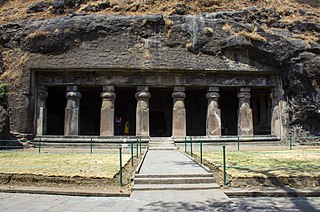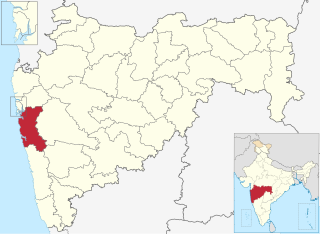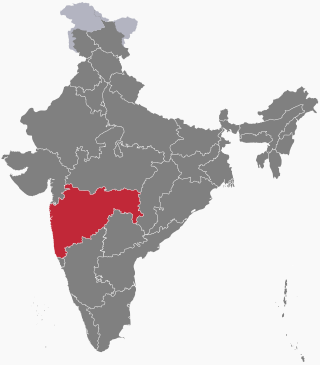Related Research Articles

A cloudburst is an enormous amount of precipitation in a short period of time, sometimes accompanied by hail and thunder, which is capable of creating flood conditions. Cloudbursts can quickly dump large amounts of water, e.g. 25 mm of the precipitation corresponds to 25,000 metric tons per square kilometre. However, cloudbursts are infrequent as they occur only via orographic lift or occasionally when a warm air parcel mixes with cooler air, resulting in sudden condensation. At times, a large amount of runoff from higher elevations is mistakenly conflated with a cloudburst. The term "cloudburst" arose from the notion that clouds were akin to water balloons and could burst, resulting in rapid precipitation. Though this idea has since been disproven, the term remains in use.

The Mumbai–Pune Expressway is India's first 6-lane wide concrete, access-controlled tolled expressway. It spans a distance of 94.5km connecting Raigad-Navi Mumbai-Mumbai, the capital of Maharashtra state and the financial capital of India, with Pune, the cultural and educational capital of Maharashtra. The expressway, which was fully operationalized in 2002, introduced new levels of speed and safety in automobile transportation to Indian roads. It is one of India's busiest roads.

Raigad district, previously Colaba district, is a district in the Konkan division of Maharashtra, India. The headquarters of the district is Alibag. Other major cities in the district are Panvel, Karjat, Navi Mumbai, Khopoli, Shrivardhan and Mahad.

The 1989 North Indian Ocean cyclone season was a below-average season in annual cycle of tropical cyclone formation. Despite this, the season had the second highest Accumulated Cyclone Energy in the basin on record behind only 2019 and 2023. The season has no official bounds but cyclones tend to form between April and December. These dates conventionally delimit the period of each year when most tropical cyclones form in the northern Indian Ocean. There are two main seas in the North Indian Ocean—the Bay of Bengal to the east of the Indian subcontinent and the Arabian Sea to the west of India. The official Regional Specialized Meteorological Centre in this basin is the India Meteorological Department (IMD), while the Joint Typhoon Warning Center (JTWC) releases unofficial advisories. An average of five tropical cyclones form in the North Indian Ocean every season with peaks in May and November. Cyclones occurring between the meridians 45°E and 100°E are included in the season by the IMD.
Events in the year 2010 in China.

The National Disaster Response Force (NDRF) is a specialized force in India, tasked with the responsibility of responding to natural and man-made disasters. It operates under the National Disaster Management Authority of Ministry of Home Affairs and was established in 2006 with the aim of strengthening disaster management capabilities in the country

On 30 July 2014, a landslide occurred in the village of Malin in the Ambegaon taluka of the Pune district in Maharashtra, India. The landslide, which hit early in the morning while residents were asleep, was believed to have been caused by a burst of heavy rainfall, and killed at least 151 people. Rains continued after the landslide making rescue efforts difficult.
This is a list of notable recorded floods that have occurred in India. Floods are the most common natural disaster in India. The heaviest southwest, the Brahmaputra, and other rivers to distend their banks, often flooding surrounding areas.

On 25 August 2020, a building collapsed in Mahad, India killing at least 12 people and trapping at least 60 others.
In June 2021, the flood in Melamchi River caused damage in the Melamchi Bazar in Sindhupalchowk District of Nepal killing several locals and some foreigners

The 2021 Mumbai landslide was a series of landslides that occurred in Chembur and Vikhroli, the suburban neighbourhood located in Mumbai, India on 18 July 2021. At least thirty-two people were killed and several others injured after they were trapped under houses that collapsed due to landslides caused by heavy rains. Prime Minister Narendra Modi expressed his grief over the loss of lives and announced ₹2 lakh ex-gratia for family of each deceased victim while a sum of ₹50,000 would be given to the injured from the Prime Minister's National Relief Fund.

A series of floods took place across the Indian State of Maharashtra in 2021. As of 28 July 2021, around 251 people have died and over 100 are still missing due to floods and landslides. 13 districts have been affected in western Maharashtra. Damage was calculated to be Rs4,000 crore.
A large landslide occurred in Noney district of the Indian state of Manipur near the Tupul railway construction site on the night of 30 June 2022. It killed 58 people and three people were missing. Eighteen people were injured. Twenty-nine Indian Army personnel and 29 civilians were among the deceased. Of the missing three people, two were civilians and one was an Indian Army personnel.

After over 6,500 people died in flooding in 2020, monsoon floods hit South Asia again in 2021.

The following is a list of weather events that occurred on Earth in the year 2023. The year saw a transition from La Niña to El Niño, with record high global average surface temperatures. There were several natural disasters around the world from various types of weather, including blizzards, cold waves, droughts, heat waves, wildfires, floods, tornadoes, and tropical cyclones. The deadliest weather event of the year was Storm Daniel, which killed over 5,900 people, with most of the fatalities coming from Libya. The costliest weather event of the year was Typhoon Doksuri, which caused $28.5 billion in damages in China, the Philippines and Taiwan. Another significant weather event was Cyclone Freddy, which became the longest lasting tropical cyclone on record, beating the previous mark of Hurricane John in 1994. The storm caused 1,434 fatalities, with most of the deaths coming from Malawi.

Heavy rainfall during the 2023 monsoon season resulted in severe flooding and landslides across Northern India, primarily affecting residents in Himachal Pradesh, Punjab, Chandigarh, Uttarakhand, Jammu and Kashmir, Haryana, Rajasthan and Delhi.
A landslide occurred on 19 February 2024 in Nuristan Province of eastern Afghanistan, killing at least 25 people while the village was washed away.
On 28 November 2024, heavy rainfall caused a series of landslides to strike six villages in the Bulambuli District, located in mountainous regions of eastern Uganda. The damage caused by the landslides caused the deaths of at least 20 people, with 113 reported by Ugandan police as missing.
References
- 1 2 3 4 "Maharashtra: Sixteen dead, dozens trapped in deadly India landslide". BBC News. 2023-07-21. Archived from the original on 2023-07-21. Retrieved 2023-07-21.
- 1 2 "Raigad landslide July 20 updates : Rescue operations called off for the day; NDRF confirms 16 deaths". The Hindu . 20 July 2023. Archived from the original on 21 July 2023. Retrieved 20 July 2023.
- 1 2 3 Mascarenhas, Francis; Jamkhandikar, Shilpa (2023-07-20). "Ten dead, more than a 100 feared trapped in landslide in India after heavy rain". Reuters. Archived from the original on 2023-07-20. Retrieved 2023-07-20.
- 1 2 "India: Deadly landslide traps several under debris – DW – 07/20/2023". dw.com. Archived from the original on 2023-07-21. Retrieved 2023-07-20.
- ↑ "Landslide in Maharashtra's Raigad, 22 people rescued, many feared trapped". The Times of India. 2023-07-20. ISSN 0971-8257. Archived from the original on 2023-07-21. Retrieved 2023-07-20.
- ↑ "India: Five dead, some trapped, in landslide in Maharashtra after heavy rain". WION. Archived from the original on 2023-07-21. Retrieved 2023-07-20.
- ↑ "At least 10 people killed, some 100 feared trapped after landslide in India". France 24. 2023-07-20. Archived from the original on 2023-07-21. Retrieved 2023-07-20.
- ↑ "Delhi races to drain floodwaters with more rain expected – DW – 07/14/2023". dw.com. Archived from the original on 2023-07-21. Retrieved 2023-07-20.
- ↑ Express News Service (20 July 2023). "At least 16 dead, over 100 feared trapped as landslide buries Maharashtra village". Indian Express. Archived from the original on 21 July 2023. Retrieved 22 July 2023.
- ↑ Raigad landslide | Death toll rises to 25; 83 persons yet to be traced Archived 2023-07-22 at the Wayback Machine , The Hindu
- ↑ Mascarenhas, Francis; Jamkhandikar, Shilpa (2023-07-20). "Indian landslide kills 16, rescue operations paused". Reuters. Archived from the original on 2023-07-20. Retrieved 2023-07-21.
- ↑ "More than a 100 feared trapped in landslide in India". Yahoo News. 2023-07-20. Archived from the original on 2023-07-21. Retrieved 2023-07-20.
- ↑ "5 killed, 100 feared trapped in landslide in India | Sada Elbalad". see.news. Archived from the original on 2023-07-21. Retrieved 2023-07-20.
- ↑ Yasir, Sameer; Kumar, Hari (2023-07-20). "Landslide Kills at Least 10 in Western India". The New York Times. ISSN 0362-4331. Archived from the original on 2023-07-21. Retrieved 2023-07-21.